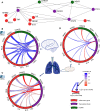The Neat Dance of COVID-19: NEAT1, DANCR, and Co-Modulated Cholinergic RNAs Link to Inflammation
- PMID: 33163005
- PMCID: PMC7581732
- DOI: 10.3389/fimmu.2020.590870
The Neat Dance of COVID-19: NEAT1, DANCR, and Co-Modulated Cholinergic RNAs Link to Inflammation
Abstract
The COVID-19 pandemic exerts inflammation-related parasympathetic complications and post-infection manifestations with major inter-individual variability. To seek the corresponding transcriptomic origins for the impact of COVID-19 infection and its aftermath consequences, we sought the relevance of long and short non-coding RNAs (ncRNAs) for susceptibility to COVID-19 infection. We selected inflammation-prone men and women of diverse ages among the cohort of Genome Tissue expression (GTEx) by mining RNA-seq datasets from their lung, and blood tissues, followed by quantitative qRT-PCR, bioinformatics-based network analyses and thorough statistics compared to brain cell culture and infection tests with COVID-19 and H1N1 viruses. In lung tissues from 57 inflammation-prone, but not other GTEx donors, we discovered sharp declines of the lung pathology-associated ncRNA DANCR and the nuclear paraspeckles forming neuroprotective ncRNA NEAT1. Accompanying increases in the acetylcholine-regulating transcripts capable of controlling inflammation co-appeared in SARS-CoV-2 infected but not H1N1 influenza infected lung cells. The lung cells-characteristic DANCR and NEAT1 association with inflammation-controlling transcripts could not be observed in blood cells, weakened with age and presented sex-dependent links in GTEx lung RNA-seq dataset. Supporting active involvement in the inflammatory risks accompanying COVID-19, DANCR's decline associated with decrease of the COVID-19-related cellular transcript ACE2 and with sex-related increases in coding transcripts potentiating acetylcholine signaling. Furthermore, transcription factors (TFs) in lung, brain and cultured infected cells created networks with the candidate transcripts, indicating tissue-specific expression patterns. Supporting links of post-infection inflammatory and cognitive damages with cholinergic mal-functioning, man and woman-originated cultured cholinergic neurons presented differentiation-related increases of DANCR and NEAT1 targeting microRNAs. Briefly, changes in ncRNAs and TFs from inflammation-prone human lung tissues, SARS-CoV-2-infected lung cells and man and woman-derived differentiated cholinergic neurons reflected the inflammatory pathobiology related to COVID-19. By shifting ncRNA differences into comparative diagnostic and therapeutic profiles, our RNA-sequencing based Resource can identify ncRNA regulating candidates for COVID-19 and its associated immediate and predicted long-term inflammation and neurological complications, and sex-related therapeutics thereof. Our findings encourage diagnostics of involved tissue, and further investigation of NEAT1-inducing statins and anti-cholinergic medications in the COVID-19 context.
Keywords: COVID-19; central nervous system; cholinergic; long non-coding RNA; miRNA.
Copyright © 2020 Meydan, Madrer and Soreq.
Figures







Similar articles
-
Competitive Endogenous RNA Network Activates Host Immune Response in SARS-CoV-2-, panH1N1 (A/California/07/2009)-, and H7N9 (A/Shanghai/1/2013)-Infected Cells.Cells. 2022 Jan 30;11(3):487. doi: 10.3390/cells11030487. Cells. 2022. PMID: 35159296 Free PMC article.
-
A new insight into sex-specific non-coding RNAs and networks in response to SARS-CoV-2.Infect Genet Evol. 2022 Jan;97:105195. doi: 10.1016/j.meegid.2021.105195. Epub 2021 Dec 23. Infect Genet Evol. 2022. PMID: 34954105 Free PMC article.
-
Human long noncoding RNA VILMIR is induced by major respiratory viral infections and modulates the host interferon response.J Virol. 2025 Apr 15;99(4):e0014125. doi: 10.1128/jvi.00141-25. Epub 2025 Mar 25. J Virol. 2025. PMID: 40130878 Free PMC article.
-
Illuminating the pathogenic role of SARS-CoV-2: Insights into competing endogenous RNAs (ceRNAs) regulatory networks.Infect Genet Evol. 2024 Aug;122:105613. doi: 10.1016/j.meegid.2024.105613. Epub 2024 Jun 4. Infect Genet Evol. 2024. PMID: 38844190 Review.
-
Emerging role of microRNAs and long non-coding RNAs in COVID-19 with implications to therapeutics.Gene. 2023 Apr 20;861:147232. doi: 10.1016/j.gene.2023.147232. Epub 2023 Feb 2. Gene. 2023. PMID: 36736508 Free PMC article. Review.
Cited by
-
Human-derived air-liquid interface cultures decipher Alzheimer's disease-SARS-CoV-2 crosstalk in the olfactory mucosa.J Neuroinflammation. 2023 Dec 14;20(1):299. doi: 10.1186/s12974-023-02979-4. J Neuroinflammation. 2023. PMID: 38098019 Free PMC article.
-
COVID-19: Mechanisms, risk factors, genetics, non-coding RNAs and neurologic impairments.Noncoding RNA Res. 2023 Jun;8(2):240-254. doi: 10.1016/j.ncrna.2023.02.007. Epub 2023 Feb 23. Noncoding RNA Res. 2023. PMID: 36852336 Free PMC article. Review.
-
Therapeutic prospects of ceRNAs in COVID-19.Front Cell Infect Microbiol. 2022 Sep 20;12:998748. doi: 10.3389/fcimb.2022.998748. eCollection 2022. Front Cell Infect Microbiol. 2022. PMID: 36204652 Free PMC article. Review.
-
New Imaging Modality of COVID-19 Pneumonia Developed on the Basis of Alzheimer's Disease Research.Int J Mol Sci. 2022 Jul 29;23(15):8405. doi: 10.3390/ijms23158405. Int J Mol Sci. 2022. PMID: 35955536 Free PMC article.
-
Non-coding RNAs expression in SARS-CoV-2 infection: pathogenesis, clinical significance, and therapeutic targets.Signal Transduct Target Ther. 2023 Dec 6;8(1):441. doi: 10.1038/s41392-023-01669-0. Signal Transduct Target Ther. 2023. PMID: 38057315 Free PMC article. Review.
References
Publication types
MeSH terms
Substances
Grants and funding
LinkOut - more resources
Full Text Sources
Medical
Research Materials
Miscellaneous

